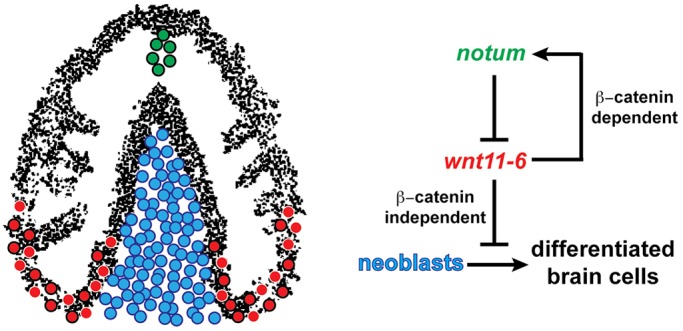Fig. 8.

notum/wnt11-6 feedback regulation dampens brain cell differentiation to achieve proper brain:body scaling. (Left) Cartoon depicting planarian brain with neurons (black), wnt11-6-expressing neurons (red with black outline) and other brain-associated cell types (red with white outline) in the posterior brain region (red), notum-expressing neurons at the anterior commissure (green with black outline) and neoblasts that surround the brain (blue, medial neoblasts shown). (Right) Model for regulatory pathway influencing brain size. wnt11-6 inhibits neoblast production of differentiated brain cells (including cintillo+, gad+, trpA+ and tph+ neurons) by suppressing formation or division of neural progenitors (ap2+smedwi-1+, coe+smedwi-1+ and lhx1/5-1+smedwi-1+ cells) from pluripotent neoblasts. wnt11-6 signals directly or indirectly through β-catenin-dependent canonical Wnt signaling to activate expression of notum in neurons at the anterior brain commissure. wnt11-6 is likely to signal independently of beta-catenin-1 in control of neoblasts to suppress brain size. notum encodes a secreted protein that inhibits wnt11-6 function to promote ongoing synthesis of brain cells from neoblasts. Levels of wnt11-6 and notum signaling control numbers of neoblasts committing to brain cell fates to influence the size of the brain.
